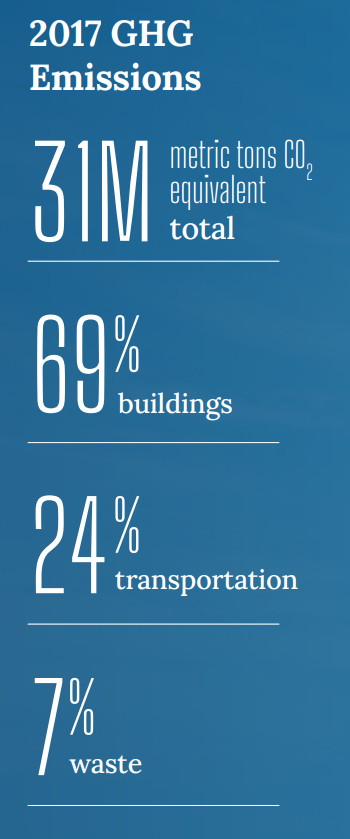Electrify Chicago
An independent tool for viewing City of Chicago building data
According to the
2022 Chicago Climate Action Plan,
69% of Chicago's emissions come from buildings, making
building emissions our biggest challenge and our biggest opportunity as a city
to tackle climate change. At Electrify Chicago, we showcase building performance using
publicly available data supplemented by community-submitted photographs and building
owners.
Start by looking at Chicago's buildings with the highest greenhouse gas intensity i.e. emissions per square foot. Large, efficient, buildings can perform much better than very inefficient small buildings on this metric.
New Article
📰 $30 Million In Missed Fines
The City Of Chicago failed to collect $30 million in potential fines from the building benchmarking ordinance, reducing transparency and accountability.
Legislative update! 🎉
As of late January 2024, legislation is being introduced to require new use more efficient forms of water and space heating, via the Clean And Affordable Buildings Ordinance (CABO), which will reduce the number of highly polluting and inefficient buildings that end up on this site.
If you're in Chicago,
write to your alderman to support the CABO!
Chicago Buildings by Greenhouse Gas Intensity
Note: Data includes large Chicago buildings with data from 2022, unless explicitly stated otherwise.
Note: This data only includes buildings whose emissions are reported
under the
Chicago Energy Benchmarking Ordinance. According to the City “As of 2016,
this list includes all commercial, institutional, and residential buildings larger than
50,000 square feet.” This dataset is also then filtered to only buildings with
reported emissions > 1,000 metric tons CO2 equivalent.
The latest year of data is from 2022, but we update the site regularly when new data is available, and some buildings may have failed to report that year, and only have older data available.
| Property Name / address | Primary Property Type |
Greenhouse Gas Intensity (kg CO2 eq./sqft) |
Total Greenhouse Emissions (metric tons CO2 eq.) |
|---|---|---|---|
|
2728 N HAMPDEN CT
2728 N HAMPDEN CT
| Multifamily Housing | 7.8 kg/sqft
Highest 27%
| 1,094 tons
Highest 42%
|
|
1617 E 50TH PL
1617 E 50TH PL
| Multifamily Housing | 7.8 kg/sqft
Highest 27%
| 462 tons
Lowest 22%
|
|
Spoke Apartments
728 N Morgan St
| Multifamily Housing | 7.8 kg/sqft
Highest 27%
| 2,707 tons
Highest 16%
|
|
ONE 333
1333 S WABASH AVE
| Multifamily Housing | 7.8 kg/sqft
Highest 27%
| 2,082 tons
Highest 22%
|
|
Centrum Wicker Park
1664 W Division St
| Multifamily Housing | 7.8 kg/sqft
Highest 27%
| 552 tons
Lowest 30%
|
|
Niche 905
905 N Orleans St
| Multifamily Housing | 7.8 kg/sqft
Highest 27%
| 1,389 tons
Highest 34%
|
|
Helwig Recreation Center
(North Park)
3205 W Carmen Ave
| College/University | 7.8 kg/sqft
Highest 27%
| 514 tons
Lowest 28%
|
|
Gary Comer Youth Center (South Shore Drill Team)
7200 S Ingleside Ave
| Other | 7.8 kg/sqft
Highest 27%
| 626 tons
Lowest 35%
|
|
Hampton Inn Majestic
🕰️
22 W Monroe St
| Hotel | 7.8 kg/sqft | 547 tons |
|
820 S Michigan Ave
820 S Michigan Ave
| Multifamily Housing | 7.8 kg/sqft
Highest 27%
| 885 tons
Lowest 50%
|
|
Beasley Academic Magnet -CPS
(CPS)
5235 S State St
| K-12 School | 7.8 kg/sqft
Highest 27%
| 1,210 tons
Highest 39%
|
|
West Park Academy Of Fine Arts & Tech -CPS
(CPS)
1425 N Tripp Ave
| K-12 School | 7.8 kg/sqft
Highest 27%
| 631 tons
Lowest 35%
|
|
Gillespie Elementary -CPS
🕰️
(CPS)
9301 S State St
| K-12 School | 7.8 kg/sqft | 713 tons |
|
Pulaski Fine Arts Academy, Casimir -CPS
(CPS)
2230 W Mclean Ave
| K-12 School | 7.8 kg/sqft
Highest 27%
| 812 tons
Lowest 47%
|
|
Brighton Park-Old Building -CPS
🕰️
(CPS)
3825 S Washtenaw Ave
| K-12 School | 7.8 kg/sqft | 627 tons |
Data Source:
Chicago Energy Benchmarking Data
